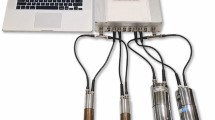Abstract
SEVERAL years ago it was shown1 that the luminosity from a shocked bed of granular sodium chloride depends only very slightly on the nature of the interstitial gas, even though it is clear2,3 that the temperature of two gases with very different properties, shocked to the same pressure, will differ by several thousand degrees centigrade over a wide range of shock strengths. This independence of the luminosity in a shocked pressing of an inert substance was presumed to apply also to detonation waves in pressings of granular explosives, an extrapolation which can be inferred from evidence presented by Paterson4. On the other hand, in Plate X of Taylor's book on condensed explosives5 a non-time-resolved slit picture is reproduced which shows very different luminosities from three different sections of a PETN charge filled individually with butane, air, or argon. That experiment, performed by I. G. Cumming, leads to the conclusion6 that the luminosity in question results from shock compression of the interstitial gas. The apparent contradiction between the two experiments should be resolved, since the dependence or independence of the luminosity on the interstitial gas may have an important bearing on the mechanism of the primary stage in shock initiation of granular explosive charges.
This is a preview of subscription content, access via your institution
Access options
Subscribe to this journal
Receive 51 print issues and online access
$199.00 per year
only $3.90 per issue
Buy this article
- Purchase on Springer Link
- Instant access to full article PDF
Prices may be subject to local taxes which are calculated during checkout
Similar content being viewed by others
References
Blackburn, J. H., and Seely, L. B., Nature, 194, 370 (1962).
Johansson, C. H., Explosivstoffe, 11, 256 (1963).
Reynolds, C. E., and Seely, L. B., Nature, 199, 341 (1963).
Paterson, S., Nature, 167, 479 (1951).
Taylor, J., Detonation in Condensed Explosives (Oxford, 1952).
Taylor, J., Detonation in Condensed Explosives, 174 (Oxford, 1952).
Author information
Authors and Affiliations
Rights and permissions
About this article
Cite this article
BLACKBURN, J., SEELY, L. Light Intensity from Detonating PETN Pressings filled with Butane. Nature 202, 382–383 (1964). https://doi.org/10.1038/202382a0
Issue Date:
DOI: https://doi.org/10.1038/202382a0
This article is cited by
-
Light from Shocked and Detonating Powders
Nature (1964)
Comments
By submitting a comment you agree to abide by our Terms and Community Guidelines. If you find something abusive or that does not comply with our terms or guidelines please flag it as inappropriate.



